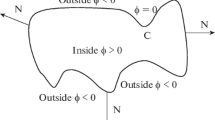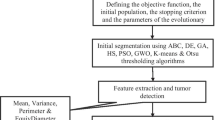Abstract
The human brain is quite complex in structure due to which it becomes quite challenging for a radiologist to differentiate tumor from normal tissues, blood clots, and edema. This paper presents a technique to segment the brain tumor from magnetic resonance images using the river formation dynamics (RFD) algorithm and active contour model. The brain tumor segmentation problem is modeled as a combinatorial optimization problem. It searches the tumor boundary using the active contour model which further uses RFD to search the optimized path in a region. RFD is heuristic optimization algorithm that mimics the way the water leads to the formation of rivers through erosion of ground and deposition of sediments. As a result, the best possible boundary with the minimum value of energy function is obtained. The technique has been evaluated quantitatively and qualitatively on the BrainWeb dataset. The results indicate the remarkable improvement over a few metaheuristic techniques, namely ant colony optimization algorithm, bacterial foraging optimization, particle swarm optimization algorithm, genetic algorithm, firefly algorithm, and cuckoo search optimization algorithm in terms of specificity, sensitivity, dice index, Hausdorff distance, Jaccard index, and accuracy. The presented approach gives continuous and smooth contours with an accuracy of 98.1% and is computationally faster in comparison to other metaheuristic techniques.


Similar content being viewed by others
References
Barnholtz-Sloan JS, Ostrom QT, Cote D (2018) Epidemiology of brain tumors. Neurol Clin 36:395–419. https://doi.org/10.1016/j.ncl.2018.04.001
Rouse C, Gittleman H, Ostrom QT, Kruchko C, Barnholtz-Sloan JS (2016) Years of potential life lost for brain and CNS tumors relative to other cancers in adults in the United States. Neuro-Oncology 18(1):70–77. https://doi.org/10.1093/neuonc/nov249
Alia OM, Mandava R, Aziz ME (2011) A hybrid harmony search algorithm for MRI brain segmentation. Evol Intell 4:31–49. https://doi.org/10.1007/s12065-011-0048-1
Hiralal R, Menon HP (2016) A survey of brain MRI image segmentation methods and the issues involved. The international symposium on intelligent systems technologies and applications. Springer, Cham, pp 245–259
Gordillo N, Montseny E, Sobrevilla P (2013) State of the art survey on MRI brain tumor segmentation. Magn Reson Imaging 31:1426–1438. https://doi.org/10.1016/j.mri.2013.05.002
El-Dahshan E-SA, Mohsen HM, Revett K, Salem A-BM (2014) Computer-aided diagnosis of human brain tumor through MRI: a survey and a new algorithm. Expert Syst Appl 41:5526–5545. https://doi.org/10.1016/j.eswa.2014.01.021
Despotović I, Goossens B, Philips W (2015) MRI segmentation of the human brain: challenges, methods, and applications. Comput Math Methods Med 2015:1–23. https://doi.org/10.1155/2015/450341
Pereira C, Ferreira M (2013) Optic disc detection in color fundus images using ant colony optimization. Med Biol Eng Comput 51:295–303. https://doi.org/10.1007/s11517-012-0994-5
Kaya IE, Pehlivanlı AÇ, Sekizkardeş EG, Ibrikci T (2017) PCA based clustering for brain tumor segmentation of T1w MRI images. Comput Methods Programs Biomed 140:19–28. https://doi.org/10.1016/j.cmpb.2016.11.011
Işın A, Direkoğlu C, Şah M (2016) Review of MRI-based brain tumor image segmentation using deep learning methods. Procedia Comput Sci 102:317–324. https://doi.org/10.1016/j.procs.2016.09.407
Havaei M, Davy A, Warde-Farley D, Biard A, Courville A, Bengio Y, Pal C, Jodoin PM, Larochelle H (2017) Brain tumor segmentation with deep neural networks. Med Image Anal 35:18–31. https://doi.org/10.1016/j.media.2016.05.004
Akkus Z, Galimzianova A, Hoogi A, Rubin DL, Erickson BJ (2017) Deep learning for brain MRI segmentation: state of the art and future directions. J Digit Imaging 30:449–459. https://doi.org/10.1007/s10278-017-9983-4
Amin J, Sharif M, Yasmin M, Fernandes SL (2018) Big data analysis for brain tumor detection: deep convolutional neural networks. Futur Gener Comput Syst 87:290–297. https://doi.org/10.1016/j.future.2018.04.065
Kang J, Ullah Z, Gwak J (2021) Mri-based brain tumor classification using ensemble of deep features and machine learning classifiers. Sensors. https://doi.org/10.3390/s21062222
Rehman A, Khan MA, Saba T, Mehmood Z, Tariq U, Ayesha N (2021) Microscopic brain tumor detection and classification using 3D CNN and feature selection architecture. Microsc Res Tech 84:133–149. https://doi.org/10.1002/jemt.23597
Gopal NN, Karnan M (2010) Diagnose brain tumor through MRI using image processing clustering algorithms such as Fuzzy C means along with intelligent optimization techniques. In: 2010 IEEE international conference on computational intelligence and computing research. IEEE, pp 1–4
Dahab DA, Ghoniemy SSA, Selim GM (2012) Automated brain tumor detection and identification using image processing and probabilistic neural network techniques. Int J Image Process Vis Commun 1:2319–1724
Karnan M, Logheshwari T (2010) Improved implementation of brain MRI image segmentation using ant colony system. In: IEEE international conference on computational intelligence and computing research. IEEE, pp 1–4
Ben George E, Karnan M (2012) MR brain image segmentation using bacteria foraging optimization algorithm. Int J Eng Technol 4:295–301
Kaushik D, Utkarsha S, Singhal P, Singh V (2014) Brain tumor segmentation using genetic algorithm. Int J Comput Appl ICACEA. https://doi.org/10.15662/IJAREEIE.2016.0503043
Jothi G, Inbarani HH (2016) Hybrid tolerance rough set-firefly based supervised feature selection for MRI brain tumor image classification. Appl Soft Comput 46:639–651. https://doi.org/10.1016/j.asoc.2016.03.014
Mahalakshmi S, Velmurugan T (2015) Detection of brain tumor by particle swarm optimization using image segmentation. Indian J Sci Technol 8:1–7. https://doi.org/10.17485/ijst/2015/v8i22/79092
Ilunga-Mbuyamba E, Cruz-Duarte JM, Avina-Cervantes JG, Correa-Cely CR, Lindner D, Chalopin C (2016) Active contours driven by cuckoo search strategy for brain tumour images segmentation. Expert Syst Appl 56:59–68. https://doi.org/10.1016/j.eswa.2016.02.048
Pruthi J, Arora S, Khanna K (2018) Metaheuristic techniques for detection of optic disc in retinal fundus images. 3D Res 9:47. https://doi.org/10.1007/s13319-018-0198-3
Pruthi J, Khanna K, Arora S (2020) Optic cup segmentation from retinal fundus images using glowworm swarm optimization for glaucoma detection. Biomed Signal Process Control 60:102004. https://doi.org/10.1016/j.bspc.2020.102004
Rabanal P, Rodríguez I, Rubio F (2007) Using river formation dynamics to design heuristic algorithms. Unconventional computation. Springer, Berlin Heidelberg, pp 163–177
Kass M, Witkin A, Terzopoulos D (1988) Snakes: active contour models. Int J Comput Vis 1:321–331. https://doi.org/10.1007/BF00133570
Rabanal P, Rodríguez I, Rubio F (2011) Studying the application of ant colony optimization and river formation dynamics to the steiner tree problem. Evol Intell 4:51–65. https://doi.org/10.1007/s12065-011-0049-0
Redlarski G, Dabkowski M, Palkowski A (2017) Generating optimal paths in dynamic environments using river formation dynamics algorithm. J Comput Sci 20:8–16. https://doi.org/10.1016/j.jocs.2017.03.002
Feng Y, Wang Z (2011) Ant colony optimization for image segmentation. In: Ostfeld A (ed) Ant colony optimization-methods and applications. InTech, London
Cocosco CA, Kollokian V, Kwan RKS, Evans AC (1997) “BrainWeb: Online Interface to a 3D MRI Simulated Brain Database” NeuroImage, vol.5, no.4, part 2/4, S425, Proceedings of 3-rd International Conference on Functional Mapping of the Human Brain, Copenhagen
Author information
Authors and Affiliations
Corresponding author
Ethics declarations
Conflict of interest
We wish to confirm that there are no known conflicts of interest associated with this publication and there has been no significant financial support for this work that could have influenced its outcome. We confirm that the manuscript has been read and approved by all the following authors and that there are no other persons who satisfied the criteria for authorship but are not listed.
Ethical approval
We further confirm that the order of authors listed in the manuscript has been approved by all of us. We confirm that we have given due consideration to the protection of intellectual property associated with this work and that there are no impediments to publication, including the timing of publication, with respect to intellectual property. In so doing we confirm that we have followed the regulations of our institutions concerning intellectual property. We confirm that we have provided a current, correct email address which is accessible by the corresponding author and which has been configured to accept email.
Additional information
Publisher's Note
Springer Nature remains neutral with regard to jurisdictional claims in published maps and institutional affiliations.
Rights and permissions
About this article
Cite this article
Pruthi, J., Arora, S. & Khanna, K. Brain tumor segmentation using river formation dynamics and active contour model in magnetic resonance images. Neural Comput & Applic 34, 11807–11816 (2022). https://doi.org/10.1007/s00521-022-07070-2
Received:
Accepted:
Published:
Issue Date:
DOI: https://doi.org/10.1007/s00521-022-07070-2




